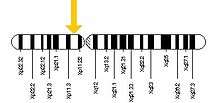Focal dermal hypoplasia
| Classification and external resources | |
|---|---|
| Specialty | medical genetics |
| ICD-10 | Q82.8 |
| ICD-9-CM | 759.89 |
| OMIM | 305600 |
| DiseasesDB | 29896 |
| eMedicine | derm/155 |
| MeSH | D005489 |
| GeneReviews | |
Focal dermal hypoplasia (also known as "Goltz syndrome") is a form of ectodermal dysplasia.[1] It is a multisystem disorder characterized primarily by skin manifestations to the atrophic and hypoplastic areas of skin which are present at birth. These defects manifest as yellow-pink bumps on the skin and pigmentation changes.[2] The disorder is also associated with shortness of stature and some evidence suggests that it can cause epilepsy.[3]
Genetics

Focal dermal hypoplasia has been associated with PORCN gene mutations on the X chromosome.[4] 90% of the individuals who are affected with the syndrome are female: the commonly accepted, though unconfirmed, explanation for this is that the non-mosaic hemizygous males are not viable.[5]
The differential diagnosis of focal dermal hypoplasia (Goltz) syndrome includes autosomal recessive Setleis syndrome due to TWIST2 gene mutations. It associated with morning glory anomaly, polymicrogyria, incontinentia pigmenti, oculocerebrocutaneous syndrome, Rothmund-Thomson syndrome and microphthalmia with linear skin defects (also known as MLS) syndrome because they are all caused by deletions or point mutations in the HCCS gene.[6]
Origin of eponyms
Jessner-Cole syndrome
The disorder was first formally recognized by dermatologists, Max Jessner and Harold Newton Cole, in the early 20th century. Jessner and Cole's papers were referenced more than any others in the first half of the 20th century.[7][8]
Goltz-Gorlin
Besides its formal name, it is most commonly referred to as Goltz-Gorlin syndrome, after Robert Goltz and Robert Gorlin.[9] Goltz and Gorlin worked together at Columbia University [10] and are credited for describing the symptoms of the disorder in more detail than ever before and tracking its genetic trends. The name became popular during the second half of the 20th century.
See also
References
- ↑ James, William; Berger, Timothy; Elston, Dirk (2005). Andrews' Diseases of the Skin: Clinical Dermatology (10th ed.). Saunders. ISBN 0-7216-2921-0.
- ↑ Goltz RW, Henderson RR, Hitch JM, Ott JE (2008). Focal dermal hypoplasia syndrome. A review of the literature and report of two cases. GeneReviews.
- ↑ Kanemura H, Hatakeyama K, Sugita K, Aihara M (2011). Epilepsy in a patient with focal dermal hypoplasia. Pediatric neurology.
- ↑ Wang X, Reid Sutton V, Omar Peraza-Llanes J, et al. (July 2007). "Mutations in X-linked PORCN, a putative regulator of Wnt signaling, cause focal dermal hypoplasia". Nat. Genet. 39 (7): 836–8. doi:10.1038/ng2057. PMID 17546030.
- ↑ Sutton, Reid. Veyver; Ignatia B Van den Veyver (1970). Focal Dermal Hypoplasia. Arch Dermatol.
- ↑ Wimplinger I, Shaw GM, Kutsche K, et al. (Aug 2007). "HCCS loss-of-function missense mutation in a female with bilateral microphthalmia and sclerocornea: a novel gene for severe ocular malformations?". Mol Vis. 13: 1475–82. PMID 17893649.
- ↑ Jessner: Naeviforme poikilodermieartige Hautveränderungen mit Missbildungen. Zentralblatt für Haut- und Geschlechtskrankheiten, 1928, 27: 468.
- ↑ H. N. Cole, et al: Ectodermal and mesodermal dysplasia with osseous involvement. Archiv für Dermatologie und Syphilis, Berlin, 1941, 44: 773-788.
- ↑ synd/1370 at Who Named It?
- ↑ R. W. Goltz, W. C. Peterson, R. J. Gorlin, H. G. Ravits: Focal dermal hypoplasia. Archives of Dermatology, Chicago, 1962, 86: 708-717.
External links
- http://www.orpha.net/consor/www/cgi-bin/OC_Exp.php?lng=EN&Expert=2092
- GeneReview/NIH/UW entry on Focal dermal hypoplasia